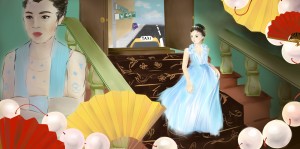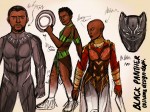From 16th-century Scotland to modern Wakanda, this year’s Oscar-nominated costume designs transported audiences to different worlds.
The designers behind costumes for all of this year’s Oscar-nominated films will discuss their work Saturday at UCLA’s Ninth Annual Sketch to Screen Costume Design Panel and Celebration. The featured panelists will include the nominated designers, as well as the designers for “Crazy Rich Asians” and “A Star Is Born,” which weren’t nominated in the design category. Professor Deborah Landis, the founding director of UCLA’s costume design center, will guide the panel through discussions of how on-screen outfits bring stories to life.
“(Costume designers) have to find out who (these characters) are, where they grew up; if they were middle children, where they went to school, what their family income was, what their passions were – the things that make you, you,” Landis said. “We’re the creators of personality, we work from the inside out.”
[RELATED: Sketch to Screen: Oscar-nominated designers to talk value of costumes at upcoming panel]
Ruth Carter, for instance, researched the many different expressions of African beauty as a starting point for her work on the “Black Panther” costumes. This beauty manifested in many forms among the Wakandan people. Turkana beadwork influenced tabards (sleeveless tunics), Mursi lip plates informed the costuming of the river tribe elder and Tuareg henna and silver adornments accessorized tribal council elders, Carter said. While dressing the Jabari tribe and the Dora Milaje warriors, the design crew made sure to use materials that resembled all parts of animals, including skin and fur, to pay homage to African groups, like the Himba women, which use the complete animal.
“Beauty was my main purpose, and the reimagining of beauty to retrain the eye as far as understanding what each of the tribes understood as beauty for them,” Carter said. “Beauty – not that which we know in American culture, but beauty in African culture – informed many of the decisions that were made for the costumes.”
[RELATED: Two Months Later: Exploring of the Cultural and Cinematic Impact of ‘Black Panther‘]
Carter said she worked closely with director Ryan Coogler to choose distinct colors to represent each tribe. The border tribe’s blue shades, for example, are a nod to the African police force which dons similar colors, Carter said. In direct contrast, she said they chose a saturated, vibrant red for the Dora Milaje warriors, amplifying the intensity of their presence.
Color represents character growth as well. Carter said she dressed Nakia, played by Lupita Nyong’o, in all green to represent her river tribe heritage. However, Carter played with shapes and shades to showcase her many layers as princess, Bond girl, warrior and more.
Color symbolism was a large part of the costuming process for “Crazy Rich Asians” as well, said designer Mary Vogt. Vogt worked closely with director Jon Chu, author Kevin Kwan and the actors to analyze the characters in depth while working on her designs, she said.

Vogt utilized deeper hues and unexpected color combinations – turquoise and lime, hot pink and orange – to reflect Singaporean style. She also played with color symbolism to reflect the story’s power dynamics, such as by dressing Rachel and Eleanor in the same shade of blue during the wedding scene.
“They have this color in common because they have the son in common, but Rachel’s dress is very soft and vulnerable, and the mother’s is more structured, so it sort of shows a little bit of their personalities,” Vogt said.
Focus on character also influenced Vogt’s designs for the film’s wedding scene. Vogt said she and her team initially planned to dress Araminta, played by Sonoya Mizuno, in a white wedding dress with a 50-foot train, but they eventually grew tired of the trite design. They instead focused on Mizuno herself, designing a tiered golden dress with a slit to showcase her ballerina strength and gracefulness. Complete with sparkling beads and a row of marabou feathers, the gown became a part of the actress, Vogt said, as Mizuno walked down the flooded aisle in her very own “Swan Lake” moment.
“You have to make sure that the actor is really comfortable in what they’re wearing. … There’s an awkwardness to everything,” Vogt said. “It’s about the performance, it’s not about some fabulous dress that’s going to take over a scene or be distracting.”
[RELATED: Panel discusses rise of Asian-American visibility, continued need for progress]
Similarly, Vogt said she pulled inspiration from actress Constance Wu to tailor a Cinderella-blue gown for her character, Rachel Chu, for the wedding. Vogt said she removed the sleeves of the original dress and scaled it down to better fit Wu, emphasizing the delicate, etherealness of the dress. The choice to evoke Cinderella was purposeful – Vogt said director Chu referenced fairytales such as “Alice in Wonderland” throughout the design process.
Landis said directors depend on costume designers to subtly create this authenticity in the movie’s look and feel. Even though costumes often have a profound impact on fashion and pop culture, costume designers – who are often women – are paid less and valued less, and it’s time to reverse that trend, Landis said.
“In order to care about (movie characters), they have to be more than paper dolls or cardboard cutouts or celebrities,” Landis said. “Costume designers create real people.”
